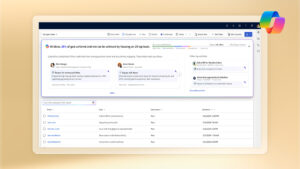Microsoft Dynamics AX 2012 at Leading Manufacturing Event
Well I hope that you enjoyed the Convergence coverage from our team last week – certainly a lot going on in particular around Microsoft Dynamics AX 2012. For those of us with a mnaufacturing focus however, the fun and games started a week before Convergence in Atlanta at the Hannover Messe where we previewed the manufacturing foundation in Microsoft Dynamics AX 2012. During the event I had the chance to catch-up with the man leading the Microsoft Dynamics AX charge in Germany, Philipp Ruediger as well as a number of partners all excited about the upcoming release. Here is a translated version of a blog post Philipp wrote prior to the start of the event. Philipp talks about the importance of Hannover Messe, the state of the manufacturing space and the role that ERP can play there as well as (not surprisingly) Microsoft Dynamics AX 2012 and some of thee capabilities the new release will offer.
The next generation of ERP by Philipp Ruediger
On April 4, Hannover Messe opens its doors, and it is with just as much eager anticipation that we are looking forward to the coming five days. Hannover will be the meeting point for the “Who’s Who” in the Manufacturing industry, and I am looking forward to interesting discussions with decision makers from medium-sized companies as well as large-scale enterprises.
The crisis is over – an effect also showing in the numbers of visitors. Right now, Germany is facing the largest economic growth since the reunification. Especially the Manufacturing industry is experiencing an encouraging upturn. This atmosphere does not only characterize the trade fair, but is also something I experience in discussions with customers, partners and analysts. Particularly in times of upswing, ERP becomes an increasingly important competitive factor. Companies have to adapt to ever changing market conditions and face the pressure of competition. In many cases, the most successful company it is not the one with the best cost structures, but the one with the higher agility. This dynamics influences both the processes and the business models in organisations: In order to react appropriately, e. g. with regard to requirements from business partners in the supply chain, they must execute process changes quickly and in a flexible manner. What’s more, companies must be able to enhance existing business models or create new ones. An example is the adoption of discrete manufacturing processes in addition to an existing process manufacturing environment as a consequence of the business decision to insource refinement/finishing processes.
With respect to traditional ERP systems in the market it can be stated that most of them originate from the 1980s. Many are using transaction based processing and reflect a backward perspective of the reality – without providing support for departmental or business critical decisions. Also BI plays a role here as it enables only time-shifted analytics, but does not provide decision support out of the procedural context. Although these components provide a proper documentation of the business transactions, they do not support an optimisation of the business itself. Also in terms of technology the traditional systems are outdated: Spaghetti of intertwined, complex code and parameters hamper modifications to the system, whereas the reality in the market space and the changing customer requirements are always at least two steps ahead. All those factors slow down the above mentioned agility – and the problem continues in other areas: inflexible processes and the time lag between new requirements in the reality and their reflection in the systems are the reasons why businesses are not able to proactively manage market and customer requirements. They act more slowly as they could and even possibly lose market share when competitors are more agile. And this also has effects on liquidity and capital.
At Hannover Messe you have the possibility to be among the first who gain insight into the new generation in ERP – one week before the worldwide launch event of Microsoft Dynamics AX 2012. With the new version, we present one of the most modern ERP systems in the market. With so called Unified Natural Models, the system allows flexible changes to your structure and process organisation, e. g. for a matrix organisation with legal entities on one side and flexible organisational elements (divisions, product lines, etc.) on the other. Companies who want to expand or even renew their business models benefit from the rich pre-built Microsoft Dynamics AX industry functionality, with proven functionality “out of the box” for Manufacturing (process and discrete), Service Industries and Retail. It is also possible to combine these industry requirements, e. g. in case of Mixed-mode manufacturing. The software supports long-term growth in the evolutionary context of our customers‘ businesses, without restricting them in a siloed architecture. Furthermore you can take advantage of rapid process changes – with the object-oriented development environment or graphical workflows.
With native support for 38 country and 42 language versions, Microsoft Dynamics AX 2012 supports your growth strategies. The software also supports different character sets like Arabic, Asiatic, Latin, and Cyrillic characters. Moreover the system provides a growth perspective in terms of scalability and the option to support up to several thousand users. Evidence how businesses use Microsoft Dynamics AX 2012 as a platform for growth can be found in the numerous case studies from upper midmarket and corporate customers. Last week I had the opportunity to talk to Hubert Meisterjahn, CIO at Alois F. Dornbracht GmbH. Dornbracht has evolved from a family firm into the market leader for high-quality bathroom fittings and accessories with 15 international locations. The company has adapted the Fractal Factory concept in order to secure the highest flexibility in using the own capacities. Each building on the company premises is designed as a module and can be used temporarily for a specific purpose. Office building, assembly hall or development unit – each of the modules can be defined for the required purpose in order to support their role as a nucleus for new product innovations. The ERP system has to reflect this flexible model: „We have made a conscious decision in favour of Microsoft Dynamics AX because we were looking for a system that supports our versatility through the company, IT or market,” says Hubertus Meisterjahn, „We were not willing to accept the corset of an inflexible system“.
This is only one of many examples showing that ERP becomes an increasingly important strategic competitive factor. Properly implemented and used, ERP lays the foundations for further growth. The prerequisite: next generation ERP. Dornbracht is the first customer in Germany who uses Microsoft Dynamics AX 2012. The video interview with Hubertus Meisterjahn will be published next week, and we will keep you updated (Luke Shave: not quite next week but watch out for the video coming soon on our WW Dynamics ERP YouTube channel!!)
Best Regards
Luke Shave
Sr. Industry Marketing Manager
Follow us on Twitter and befriend us on Facebook. Also check out our new YouTube channel




